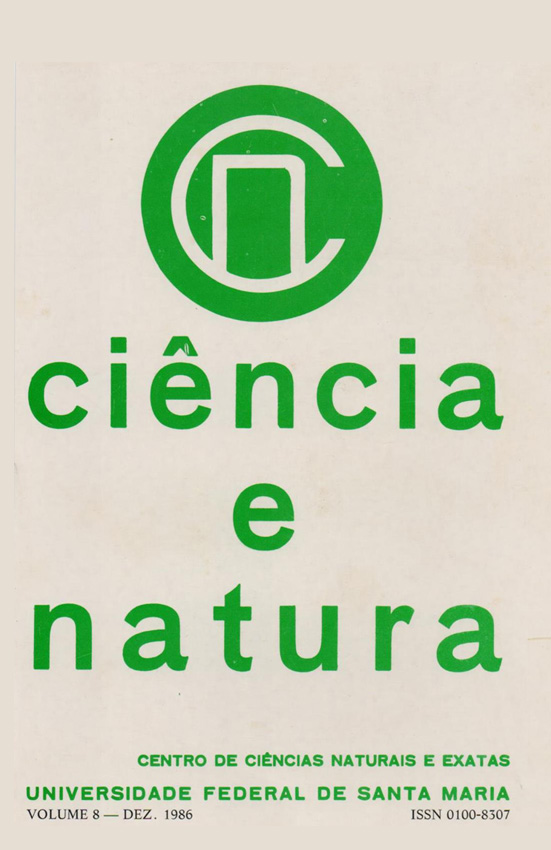Estudo anatômico da madeira de Veludinho, Guettarda uruguensis Cham. et Schlecht
DOI:
https://doi.org/10.5902/2179460X25448Resumo
É descrita a madeira de Guattarda uruguensis Cham. et Schlecht, quanto aos caracteres gesrais, microscópios e macroscópicos. A espécie mostra uma estrutura anatômica concordantes com as referências da literatura para o gênero botânico e família Rubiaceae. Dentre os caracteres, merecem destaque a ocorrência de poros extremante numerosos e muito pequenos, solitários ou em curtos múltiplos radiais, placa de perfuração simples, pontuações intervasculares pequenas e ornamentadas, parênquima axial ausente, fibras septadas e raios heterogêneos I, com predominância de bi-seriados.
Downloads
Referências
BACIGALUPO, N.M. Rubiaceae. In: BURKART, A. Flora Ilustrada de Entre Rios (Argentina). Tomo IV, 6. Buenos Aires, Coleccion Cientifica del INTA, 1974. 554 p.
COPANT. COMISION PANAMERICANA DE NORMAS TECNICAS. Descricion de caracteristicas generales, macroscopicas y microscopicas de las maderas de Angiospermas Dicotiledóneas. COPANT, 30:1-019, 1974.
KOEK-NOORMAN, J. A contribution to the Wood Anatomy of South American (chiefly Suriname) Rubiaceae. I. Acta Bot. Neerl.18 (1): 108-123. 1969.
KOEK-NOORMAN, J. A contribution to the Wood Anatomy of the South American (Chiefly Suriname) Rubiaceae. II. Acta Bot., Neerl: 18 (2):377-395.1969.
LOMBARDO, A. Flora arborea y arborescente del Uruguay. Montevideo, Concejo Departamental, s/d. 151 p.
METCALFE, C.R. & CHALK, L. Anatomy of the Dicotyledons. Oxford, Clarendon Press, 1972. 1500 p.
RECOD, S.J. & HESS, R.W. Timbers of The New World. New Haven, Yale University Press, 1949. 640 p.
REITZ, R.; KLEIN, R.M. & REIS, A. Projeto Madeira de Santa Catarina. Sellowia, 28-30: 1-320, 1978.
REITZ, R.; KLElN, R.M. & REIS, A. Projeto Madeira do Rio Grande do Sul. Sellowia, 34-35: 1-525, 1983.
Downloads
Publicado
Como Citar
Edição
Seção
Licença
Para acessar a DECLARAÇÃO DE ORIGINALIDADE E EXCLUSIVIDADE E CESSÃO DE DIREITOS AUTORAIS clique aqui.
Diretrizes Éticas para Publicação de Revistas
A revista Ciência e Natura está empenhada em garantir a ética na publicação e na qualidade dos artigos.
A conformidade com padrões de comportamento ético é, portanto, esperada de todas as partes envolvidas: Autores, Editores e Revisores.
Em particular,
Autores: Os Autores devem apresentar uma discussão objetiva sobre a importância do trabalho de pesquisa, bem como detalhes e referências suficientes para permitir que outros reproduzam as experiências. Declarações fraudulentas ou intencionalmente incorretas constituem comportamento antiético e são inaceitáveis. Artigos de Revisão também devem ser objetivos, abrangentes e relatos precisos do estado da arte. Os Autores devem assegurar que seu trabalho é uma obra totalmente original, e se o trabalho e / ou palavras de outros têm sido utilizadas, isso tem sido devidamente reconhecido. O plágio em todas as suas formas constitui um comportamento publicitário não ético e é inaceitável. Submeter o mesmo manuscrito a mais de um jornal simultaneamente constitui um comportamento publicitário não ético e é inaceitável. Os Autores não devem submeter artigos que descrevam essencialmente a mesma pesquisa a mais de uma revista. O Autor correspondente deve garantir que haja um consenso total de todos os Co-autores na aprovação da versão final do artigo e sua submissão para publicação.
Editores: Os Editores devem avaliar manuscritos exclusivamente com base no seu mérito acadêmico. Um Editor não deve usar informações não publicadas na própria pesquisa do Editor sem o consentimento expresso por escrito do Autor. Os Editores devem tomar medidas de resposta razoável quando tiverem sido apresentadas queixas éticas relativas a um manuscrito submetido ou publicado.
Revisores: Todos os manuscritos recebidos para revisão devem ser tratados como documentos confidenciais. As informações ou ideias privilegiadas obtidas através da análise por pares devem ser mantidas confidenciais e não utilizadas para vantagens pessoais. As revisões devem ser conduzidas objetivamente e as observações devem ser formuladas claramente com argumentos de apoio, de modo que os Autores possam usá-los para melhorar o artigo. Qualquer Revisor selecionado que se sinta desqualificado para rever a pesquisa relatada em um manuscrito ou sabe que sua rápida revisão será impossível deve notificar o Editor e desculpar-se do processo de revisão. Os Revisores não devem considerar manuscritos nos quais tenham conflitos de interesse resultantes de relacionamentos ou conexões competitivas, colaborativas ou outras conexões com qualquer dos autores, empresas ou instituições conectadas aos documentos.






